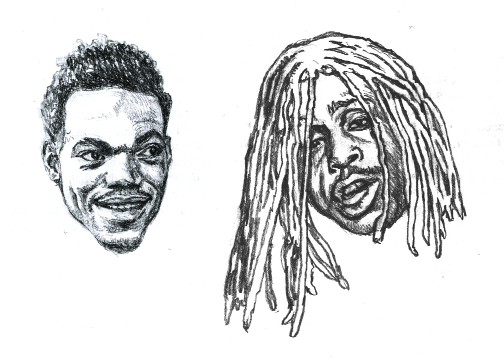Beyond Chief and Chance
Four years ago, Chicago’s 2012 was near-consumed by the rise of Chief Keef, and his explosive, Internet-driven success was the first spark that opened up space for all the artists that populate the current city-wide rap renaissance. By the end of that year, drill had been established as a mainstream sub-genre of gangster rap, complete with its own visual and sonic aesthetics as well as a journalistic moral panic that pushed to reduce black youth in Chicago to a set of violent tropes. But what came after would greatly expand and diversify the state of hip-hop in the city.
The moralizing tone that ran through much of drill rap’s media coverage was often extended to the new crop of Chicago rappers, but in the opposite way. The post-drill artists were equally as young, black, and empowered by the Internet as the drill artists were, but created vastly different music. Some tried to position Chance the Rapper, Vic Mensa, and other artists who came up in 2013 as the antithesis of drill—more positive, more conscious, less troubled, what have you. But these rappers themselves have consistently pushed back against the dichotomy of “drill rap vs. conscious rap,” and rightly so. There was certainly much that bound together the constellation of musicians who would emerge throughout the next few years, whether it was their mixtape collaborations, a shared lyrical sensibility drawn from the city’s spoken word scene, or personal friendships between the artists. The initial post-drill artists drew from a broad range of influences, making music both too diverse to fit into a single set of genre conventions and filled with a complex set of experiences not reducible to the moral opposite of drill. With Chance as the spearhead of this moment, comparisons to Chief Keef were inevitable, and the two seem to be the most important and influential rappers to emerge from Chicago in this decade. But the wave of rappers who were first bolstered by Chance’s success has never coalesced into a genre of its own, a testament to the dynamism of their music.
In the years since then, an even more diffuse third wave of Chicago hip-hop has continued along this path, with artists drawing from an even broader palette of genres and scenes including DIY, spoken word, juke, soul, gospel, jazz, and trap. This third wave of Chicago rap kept riding through 2016, which saw especially strong releases from Noname, Saba, Jamila Woods, and Joey Purp and solid projects from too many others to list. And drill itself, although never as white hot as it was in 2012, is far from narrow or dead. For every Keef copycat that didn’t achieve mainstream success, rappers like Lil Durk and G Herbo kept drill going in 2016, continuing to bring nuance, sorrow, and variety to a genre still too often pigeonholed as merely violent street rap. But it is also clear that the post-Chance constellation of rappers have become the most relevant hip-hop artists the city currently has to offer. In different ways, then, Chance and Chief Keef both opened up space for new voices to emerge and for new artists to tell their stories through music that continues to drive the culture forward. (Jordan Porto)
The State of Latinx Punk
The South Side’s primarily Latinx punk/DIY scene is one of contemporary Chicago’s greatest and deepest contributions to arts and culture (on scales both hyperlocal and global), and its continued vitality is something for all of us to be thankful for. From the nineties onward, it has been producing some of the most forward-thinking, community-minded groups. Perhaps the best known of those, Los Crudos, celebrated the quarter-century mark over a week this fall at Co-Prosperity Sphere, with events nearly every night and an art installation. And while DIY spaces come and go out of necessity, there’s at least one on the South Side that’s been nurturing the scene for over a decade, and its relative stability has much to do with the rotating cast of custodians taking good care of the place, as well as it being a part of the neighborhood, beyond punk. Most recently, newer, aboveground events like Villapalooza have emerged to include punk and its associated subgenres in a broader swath of Latinx-focused neighborhood musical acts, helping bring the vibrancy of many of the scene’s groups to a wider audience without sacrificing the intimacy of their performances or the integrity of their community bonds. (Jes Skolnik)
Chicago Jazz: The New Guard
Following an ongoing seal of approval from BBC music critic Gilles Peterson, rumor has it that Chicago’s modern jazz players are being received in England with a hero’s welcome. Crowds churn and holler, buy records, and clamorously await new releases from labels such as International Anthem, which released Chicago drummer Makaya McCraven’s widely acclaimed album In the Moment.
It’s surprising to some that jazz would stir up a clamor, but if you were at Makaya’s March 14 European send-off tour concert at The Hideout, you could understand the overwhelming force of emotion that electrifies a crowd at a jazz concert. Dance halls and clubs teamed with jazz and dance across Chicago when greats such as Sun Ra decamped on Chicago’s South Side in the forties, and some of today’s players are the true heirs to this American tradition.
Jazz at its best calls forth from the universe the primeval storyline of all human history. That show on March 14 featured Makaya on drums, Junius Paul on bass, Matt Gold on guitar, and electrifying standouts Greg Ward on saxophone and Justefan on vibraphone, and had a packed crowd on its knees until the wee hours of the morning, indicating that the new guard of Chicago jazz will continue to reach a wider audience in 2017. (Leah Menzer)

